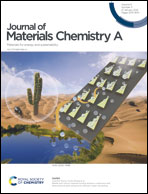Tuning the interfacial electronic structure via Au clusters for boosting photocatalytic H2 evolution†
Abstract
Gold (Au) clusters are arranged accurately at the interface of semiconductor photocatalyst (Zn0.5Cd0.5S) and conductor co-catalyst (Mo2C), achieving (Mo2C/Au)@Zn0.5Cd0.5S model configuration, where numerous Au-mediated link points can serve as multifunctional mediators for boosting photocatalytic H2 production. Specifically, they could not only enlarge the work function of co-catalyst component to provide a greater driving force for accelerating carriers' intercomponent separation, but also act as the electronic tunnels and thus switch contact mode from Schottky contact to analogous ohmic contact to eliminate the interfacial electrons transfer resistance originated from the Schottky barrier in semiconductor/conductor interface. Besides, they could also regulate the electronic configuration of co-catalyst to lower the H2 evolution overpotential of the photocatalyst system. The synergy of Zn0.5Cd0.5S, Mo2C and interfacial Au endows (Mo2C/Au)@Zn0.5Cd0.5S a soaring photocatalytic H2 evolution performance. The corresponding rate of H2 production reaches up to 21.819 mmol h−1 g−1 under visible light irradiation, which is about 28.9 times higher than that of Zn0.5Cd0.5S, even 2.7 times as high as that of Mo2C@Zn0.5Cd0.5S. The designed model structure takes full advantage of the synergy between components and interfaces via modulating interfacial structure at the atomic scale, which provides a new idea for systematically optimizing semiconductors, co-catalysts and interfaces toward efficient solar to energy conversion.



 Please wait while we load your content...
Please wait while we load your content...